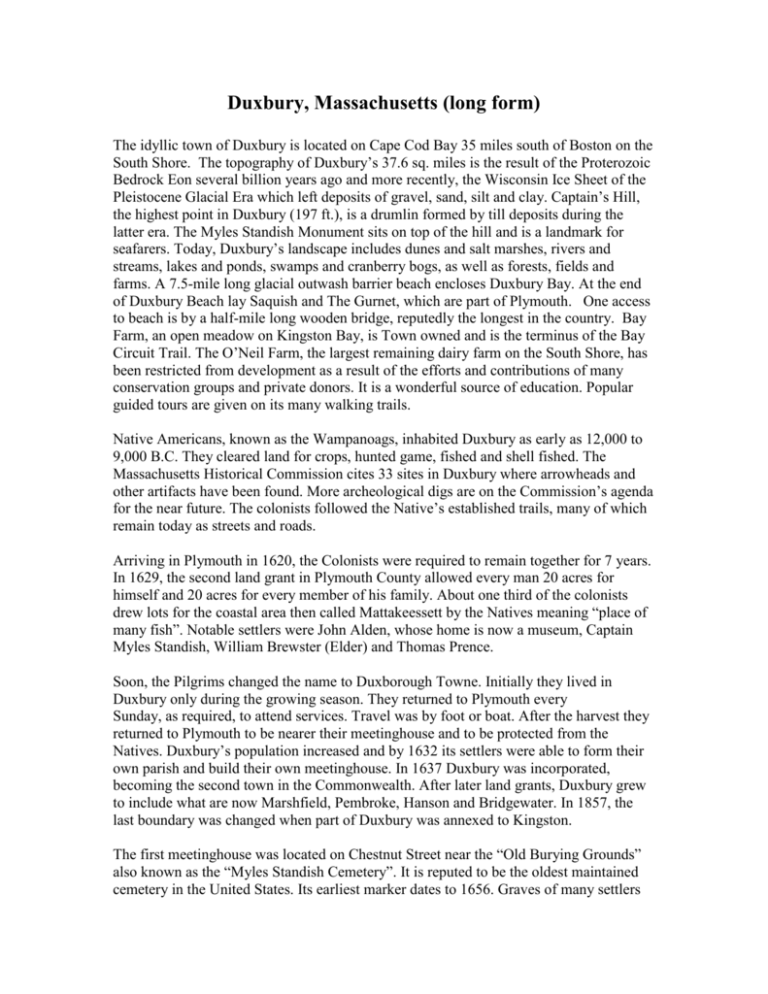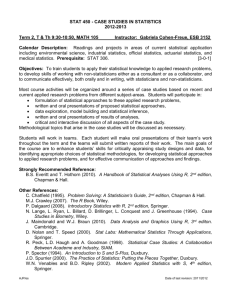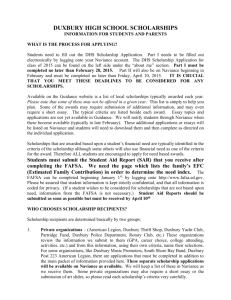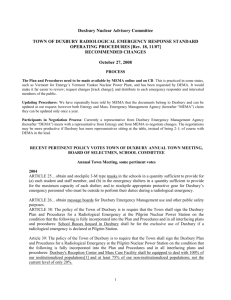DUXBURY MA HISTORY
advertisement

Duxbury, Massachusetts (long form) The idyllic town of Duxbury is located on Cape Cod Bay 35 miles south of Boston on the South Shore. The topography of Duxbury’s 37.6 sq. miles is the result of the Proterozoic Bedrock Eon several billion years ago and more recently, the Wisconsin Ice Sheet of the Pleistocene Glacial Era which left deposits of gravel, sand, silt and clay. Captain’s Hill, the highest point in Duxbury (197 ft.), is a drumlin formed by till deposits during the latter era. The Myles Standish Monument sits on top of the hill and is a landmark for seafarers. Today, Duxbury’s landscape includes dunes and salt marshes, rivers and streams, lakes and ponds, swamps and cranberry bogs, as well as forests, fields and farms. A 7.5-mile long glacial outwash barrier beach encloses Duxbury Bay. At the end of Duxbury Beach lay Saquish and The Gurnet, which are part of Plymouth. One access to beach is by a half-mile long wooden bridge, reputedly the longest in the country. Bay Farm, an open meadow on Kingston Bay, is Town owned and is the terminus of the Bay Circuit Trail. The O’Neil Farm, the largest remaining dairy farm on the South Shore, has been restricted from development as a result of the efforts and contributions of many conservation groups and private donors. It is a wonderful source of education. Popular guided tours are given on its many walking trails. Native Americans, known as the Wampanoags, inhabited Duxbury as early as 12,000 to 9,000 B.C. They cleared land for crops, hunted game, fished and shell fished. The Massachusetts Historical Commission cites 33 sites in Duxbury where arrowheads and other artifacts have been found. More archeological digs are on the Commission’s agenda for the near future. The colonists followed the Native’s established trails, many of which remain today as streets and roads. Arriving in Plymouth in 1620, the Colonists were required to remain together for 7 years. In 1629, the second land grant in Plymouth County allowed every man 20 acres for himself and 20 acres for every member of his family. About one third of the colonists drew lots for the coastal area then called Mattakeessett by the Natives meaning “place of many fish”. Notable settlers were John Alden, whose home is now a museum, Captain Myles Standish, William Brewster (Elder) and Thomas Prence. Soon, the Pilgrims changed the name to Duxborough Towne. Initially they lived in Duxbury only during the growing season. They returned to Plymouth every Sunday, as required, to attend services. Travel was by foot or boat. After the harvest they returned to Plymouth to be nearer their meetinghouse and to be protected from the Natives. Duxbury’s population increased and by 1632 its settlers were able to form their own parish and build their own meetinghouse. In 1637 Duxbury was incorporated, becoming the second town in the Commonwealth. After later land grants, Duxbury grew to include what are now Marshfield, Pembroke, Hanson and Bridgewater. In 1857, the last boundary was changed when part of Duxbury was annexed to Kingston. The first meetinghouse was located on Chestnut Street near the “Old Burying Grounds” also known as the “Myles Standish Cemetery”. It is reputed to be the oldest maintained cemetery in the United States. Its earliest marker dates to 1656. Graves of many settlers can be found there today, including those of John Alden and Myles Standish. There are plans to restore many of the headstones using Community Preservation funds. During the 17th and 18th centuries Duxbury was primarily a quiet farming and fishing community. Gristmills were needed, and in 1640, the first was built on the Duck Hill River, in an area now known as Millbrook. In 1670, a free school was planned to educate the children of Duxbury and surrounding towns. The King Phillip’s War of 1675-1678 took 41 lives, but the colonists claimed victory when King Phillip, leader of the natives, took his own life. By 1710 the population had grown to 1,100, and inland neighborhoods were established, including Island Creek, Ashdod, Gardnerville, Chandlerville and Fordville. Tinkertown was named for a Pembroke tinsmith in the mid 1700’s. About 1775 the area of Tarklin was established. Named for the tar pits and kiln located there, it indicates the early existence of a boat building industry. At that time, Duxbury’s ships supported its profitable fishing industry. In 1719, Thomas Prence operated the first shipyard of note in the Nook. By the end of the 18th century at least 180 vessels were built at some 20 shipyards. The Westons, the Drews, the Winsors and the Spragues were the most outstanding ship building families. In 1764, Ezra Weston I started his shipbuilding enterprise. He became known as “King Caesar” due to his influence and success. His son, Ezra II, inherited his father’s nickname and brought the industry to its height. By 1840, the younger Weston built the Hope, the largest vessel built in New England at that time. Even by the early 1800s, the Weston merchant fleet was the largest in the US. The Weston enterprise employed most of Duxbury’s workforce. Shipwrights, sailors, master mariners, merchants, farmers, dairymen, sail makers, lumberjacks, forgers, blacksmiths and providers of very thing needed to run the business were on the Weston payroll. The Westons owned most of the buildings and land on Powder Point. In 1808, Ezra II built a grand home overlooking the Bay and his shipyard. Original furnishings and décor were gathered on worldwide voyages and still grace the beautiful home. A lovely formal garden, known today as the “Nash Memorial Garden”, is maintained by the Community Garden Club of Duxbury and a delightful formal herb garden is maintained by the Duxbury Garden Club. Today the home is known as the “King Caesar House” and is owned and maintained by the Duxbury Rural and Historical Society (DRHS). This outstanding landmark is open to the public and is one of Duxbury’s most popular historical destinations. At the time of the Revolution, Duxbury’s population was about 1,300 and there were about 190 farms. Politically, most citizens were Whigs, supporting the Colonists, and in 1765 voted against the Stamp Act. A fort was built on the Gurnet and in 1773 a Minuteman company was formed and led by Ichabod Alden. Ten of the sixty who joined the Continental Army perished. George Partridge (1740-1828) emerged as a leader and statesman, represented Duxbury at the Second Provincial Congress and served as a delegate to the Continental Congress. In his will, he bequeathed $1000 to establish an academy that housed the upper school grades until 1928. Partridge Academy was destroyed by fire in 1935. Insurance monies enabled the Partridge Fund to be formed. To this day, the Fund provides scholarships to graduating seniors. The site is now occupied by the Town Hall. Except for the steeple, it was built to resemble the Academy. Following the Revolution, the Treaty of Paris granted the new nation fishing rights to the Grand Banks, thus furthering the need for more and larger fishing vessels. Duxbury became wealthy and world famous for having, according to Lloyds of London and Daniel Webster, the largest merchant fleet in the world. Duxbury vessels became world renown, traveling as far as Europe and China. During this shipping era, wealthy shipyard owners, master mariners and merchants built substantial homes near and along the waterfront. Today, the area between the flagpoles at Hall’s corner and Powder Point is graced with many fine examples of homes of the Colonial, Revolutionary and Ship Building eras. This area along Washington Street and several side streets is Duxbury’s only National Register Historic District, known as the Old Shipbuilders Historic District. Many short and straight side streets leading to the bay were once used by oxen to haul lumber to the shipyards. Many, of some 290 properties in the District, are date boarded and have been unusually well preserved and maintained. Today, Washington Street is one of the most charming and scenic in Duxbury. The Sweetser’s S.S. Pierce East India Company building sold goods imported from all corners of the world during the ship building era. Today the building is a landmark that houses many businesses. It abuts The Duxbury Bay Maritime School and the Town Pier. Students throughout the Boston area attend the school to learn sailing, rowing, and ecology. Nearby, popular antique stores add to the charm of this quaint area now known as Snug Harbor. In 1833, Ezra Weston II established the first bank with himself as president. In 1869, the bank building became the “Cable House”, as it was the terminus for the French Atlantic Cable. Today it exists as a private residence. Affluence increased to such a point that by 1840 it was felt that a grander meetinghouse was needed. Thus, the 1784 third meetinghouse of was razed and replaced with an elegant fourth meetinghouse now known as the First Parish Church. The annual church fair, thought to be the oldest in the US, is a highlight of the summer. By 1864, the extensive China trade was flourishing. Clipper Ships, built for their speed, reduced the demand for the slower Duxbury ships. Unfortunately for Duxbury, the harbor was too shallow for the deeper draft of the Clippers. The increasing use of steamship and railroad transportation for goods further harmed Duxbury’s ship building prosperity. Soon, the center for ship building moved to East Boston. In 1879 the “Thomas A. Goddard” was built, the last of the Duxbury vessels. The Bay is now periodically dredged. After the last dredging, according to the Harbormaster, the Bay could accommodate the Clipper Ships. Every May, the Maritime School celebrates the Opening of the Bay. Tours of sailing vessels of a by-gone era are one of the many activities of the weekend. Their arrivals and departures, viewed by many, are reminders of the Bay’s once busy seaport. Although fishing and farming had continued, new sources of income were badly needed. Cottage industries, such as shoe and boot making, cranberry growing, shell fishing, housing for summer visitors and retail stores were some of the means of sustenance. Of note was the Ford Store (1826-1921), reputed to be the first department store in America. In hopes of wealth, some men left for the California Gold Rush. Some of those who remained became unemployed. Their wives became the wage earners, barely getting by taking in laundry, caring for gardens, and taking in boarders. The Civil War of the 1860’s added to Duxbury’s economic downturn. Some 200 Duxbury men fought, 39 losing their lives. Duxbury was a frequent stop for those following the Underground Railroad. Secret hiding places have been found in homes of that era.. Fortunately, Duxbury became an increasingly popular vacation destination. The Boston and Cohasset Train was extended to Duxbury in 1871. This easy means of access resulted in a great influx of summer visitors. Horse and carriages met the vacationers at the depots and transported them to the many hotels and inns w\that were built to accommodate them. Most notable of these was the enormously popular waterfront Myles Standish Hotel. It offered numerous amenities including golf, boating and horseback riding. As vacationers began to build their own summer homes, the need for public accomodations decreased. As a result, the Standish Hotel closed in 1905. The hotel’s middle section later burned. The two outer sections were saved and remain on Standish Shore as private residences. The appearance of Duxbury had been in decline for 100 years. The Duxbury Rural Society was formed in 1883 to help beautify the town. Trash and undergrowth were removed. Highways were repaired and trees were planted along some streets. Historical locations were marked. The first parcel of land in Duxbury to be set-aside as a conservation area was purchased by the Society in 1890. Now known as the Duxbury Rural and Historical Society, its numerous members contribute much to the preservation and beauty of the town. The Society owns and maintains several historic homes available for public viewing. The Drew Archival Library is found at the newly renovated Wright Building. Here, the town’s rich collection of historical documents are housed and protected by the Society. Donations and purchases continue to add to these invaluable sources of research and education. The Society offers many interesting and informative publications about Duxbury’s colonial history. Recent publications focus on the Duxbury of today. In the 1950’s, a group of farsighted citizens realized that steps should be taken to preserve Duxbury from irresponsible growth. As a result, Duxbury was the first town in the nation to enact acre zoning. The construction of Route 3 in the 1960’s brought easier commuter service to Boston, resulting in dramatic growth. Careful planning, zoning, excellent town government and services, as well as much community involvement, contribute to the continual maintenance and improvement of the community. In 1975, in order to help preserve and protect the historical aspects of Duxbury, the Duxbury Historical Commission was established. The commission works with The Massachusetts Historical Commission as well as townspeople, town agencies, and conservation groups to insure that the goals of historic preservation are considered in planning. The Commission is charged with identifying historical resources such as archeological sites and historic properties. Recent plans to continue an historic survey will be funded through the Community Preservation Act. The Commission also administers the Duxbury Demolition Delay Bylaw that allows a six-month delay before the demolition of a historically significant structure is allowed, in the hope that time will allow for alternate plans for their preservation. The Town of Duxbury and other organizations have continued to obtain tracts of land generally known as “open space” that are restricted from development. These lands are important not only for recreational use, but also for the preservation of the natural environment and habitat. Since Duxbury does not have a sewer system, its aquifer, the only source of drinking water, must be protected from pollution. Much “open space” lies within the aquifer protection district and in areas where the aquifer is recharged. A very important resource, Duxbury Bay is carefully monitored for pollution. Much pollution has been identified and mitigated. The Bay is constantly monitored. Higher than most, the Bay’s ten-foot plus tides flush the bay twice daily, contributing to it being one of the cleanest bays in the Commonwealth. The bay offers an exceptional recreation area as well as an opportunity for residents to fish and shellfish. A recent commercial enterprise provides the bay’s world famous Island Creek Oyster. . Cranberry farming began in 1865. Today, Duxbury’s has some 500 acres of cranberry bogs. These are valuable open spaces and produce the sixth largest crop of cranberries in the state. Six quaint business areas contribute to Duxbury’s village atmosphere. Hall’s Corner, Snug Harbor and Millbrook are the main locations. Fine dining, as well as cafes, pizza shops, and delicatessens are found throughout the town. French Memories Bakery, Far Far's Ice Cream Shop and Foodies Market, all with excellent reputations, attract customers throughout the South Shore. Today, Duxbury is primarily a residential community offering numerous outstanding amenities. Among them are: excellent schools and sports teams, a lovely school campus, as well as private and pre-schools. Town owned buildings include: the Duxbury Free Library, the Percy Walker Pool, the Ellison Center for Performing Arts, the Duxbury Senior Center, the Wright Building, and the newly renovated Tarklin Community Center. Duxbury is also fortunate to have the Art Complex Museum, the South Shore Conservatory of Music, The Duxbury Art Association, and The Duxbury Bay Maritime School. There are now many houses of worship. Recreational opportunities are enjoyed at Duxbury Beach and Bay, the Town Green, North Hill Country Club, Duxbury Yacht Club, playing fields, play grounds, tennis courts and numerous hiking, biking and horse trails. As result of careful planning, excellent government, citizen’s involvement, and much town pride, Duxbury is an exceptional community, widely regarded as one of the most desirable and picturesque in Massachusetts. Leslie A. Lawrence, Member of the Duxbury Historical Commission






